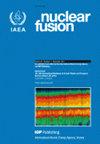Neural networks for estimation of divertor conditions in DIII-D using C III imaging
IF 4
1区 物理与天体物理
Q1 PHYSICS, FLUIDS & PLASMAS
引用次数: 0
Abstract
Deep learning approaches have been applied to images of C III emission in the lower divertor of DIII-D to develop models for estimating the level of detachment and magnetic configuration (X-point location and strike point radial location). The poloidal distance from the target to the C III emission front is used to represent the level of detachment. The models perform well on a test dataset not used in training, achieving F1 scores as high as 0.99 for detachment state classification and root mean squared error (RMSE) as low as 2 cm for front location regression. Predictions for shots with intermittent reattachment are studied, with class activation mapping used to aid in interpretation of the model predictions. Based on the success of these models, a third model was trained to predict the X-point location and strike point radial position from C III images. Though the dataset covers only a small range of possible magnetic configurations, the model shows promising results, achieving RMSE around 1 cm for the test data.利用 C III 成像估算 DIII-D 分流道状况的神经网络
深度学习方法已被应用于 DIII-D 下岔道的 C III 辐射图像,以开发用于估算脱离程度和磁配置(X 点位置和撞击点径向位置)的模型。从目标到 C III 辐射前沿的极坐标距离被用来表示脱离程度。模型在未用于训练的测试数据集上表现良好,脱离状态分类的 F1 分数高达 0.99,前沿位置回归的均方根误差 (RMSE) 低至 2 厘米。对间歇性再附着的射击预测进行了研究,并使用类激活映射来帮助解释模型预测。在这些模型取得成功的基础上,对第三个模型进行了训练,以预测 C III 图像中的 X 点位置和打击点径向位置。虽然数据集仅涵盖了一小部分可能的磁性配置,但该模型显示出良好的效果,测试数据的均方根误差(RMSE)约为 1 厘米。
本文章由计算机程序翻译,如有差异,请以英文原文为准。
求助全文
约1分钟内获得全文
求助全文
来源期刊

Nuclear Fusion
物理-物理:核物理
CiteScore
6.30
自引率
39.40%
发文量
411
审稿时长
2.6 months
期刊介绍:
Nuclear Fusion publishes articles making significant advances to the field of controlled thermonuclear fusion. The journal scope includes:
-the production, heating and confinement of high temperature plasmas;
-the physical properties of such plasmas;
-the experimental or theoretical methods of exploring or explaining them;
-fusion reactor physics;
-reactor concepts; and
-fusion technologies.
The journal has a dedicated Associate Editor for inertial confinement fusion.
 求助内容:
求助内容: 应助结果提醒方式:
应助结果提醒方式:


